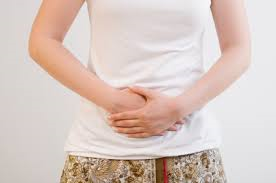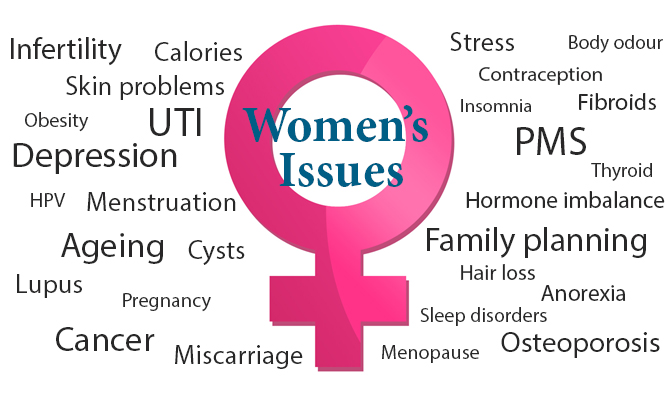INTRODUCTION There is a huge range of menstrual problems women complain of, ranging from abnormal patterns of menstrual bleeding, absence of menstrual bleeding, mild to severe menstrual ‘cramps’ and a bizarre combination of both psychological and physical problems often preceding menstrual bleeding. Emotional changes like anxiety and depression may be accompanying symptoms. In addressing the complaints presented, a doctor requires to spend time in seeking clarification and attempting to determine if the symptoms and signs point to some disease-disorder. Visiting the Doctor It would be helpful to the doctor if the patient with a menstrual problem can bring along details of her menstrual bleeding pattern and what exactly the symptoms she has. As some of the menstrual problems may be related to pregnancy, the patient would be asked about sexual history and the use of contraception. Such details are better disclosed early and honestly. It is not uncommon for patients to have gone to consult several doctors and even complementary medicine practitioners prior to consulting a specialist. All previous treatment details need to be disclosed. Some types of medication that the patient had taken previously can affect menstrual flow patterns e.g. Psychiatric medication. Again, such information needs to be disclosed. A good practice is for patients to bring along details of all that is mentioned above written out so that the consultation time can be shortened and more time can be given to discussing treatment. Once any form of treatment is given after the consultation, it is good practice for the patient to maintain a diary of all such details as in many instances the problem may last several months to years. It would also be easier for continuation of such treatment especially when the patient moves to a different location for further treatment. The discussion below does not cover pregnancy problems. Types of menstrual problems Three groups will be discussed in brief: 1. Abnormal Menstrual Pattern 2. Menstrual Cramps 3. Premenstrual Syndrome (PMS) 1. Abnormal Menstrual Pattern When we consider this problem many factors come into play e.g. the age of the patient, the use of contraceptive method, obesity, and gynaecological diseases will impact on menstrual cycles. Extremes of Age When women are in the extremes of age the menstrual pattern would not be as regular as in those who are between 18-40 years. In the young adolescent the hormones in the brain need a bit of maturation to establish some degree of synchrony and it not uncommon for young girls to complain of irregular menstrual cycles. On occasions the bleeding may be so heavy as to cause them to be anaemic. Explanation of these phenomena with reassurance is all that is needed as with time the cycles become regular. Some patients however may require female hormones to be given over periods of 21 days of a 30 day cycle so that the patient will have regular menstrual bleeding when she is not on hormones. For convenience some doctors would prescribe the oral contraceptive pills for cycle control. Both the patient and parents need to understand that oral contraceptives, in this instance are for regularising the menstrual cycle. As one grows older the ovaries that produce the female hormones are no longer as functional as in the younger women. So it is quite common for the amount of menstrual bleeding and the regularity of menstrual cycles to be affected. This is fairly common as women approach 50 years. Although in most instances one can assume that menopause is imminent, patients need to consult a doctor so that she can be evaluated and gynaecological disease be excluded. Women in the older age group (beyond 40 years) can expect to have investigations like taking a bit of tissue from the walls of the uterus (endometrial biopsy) and ultrasound examination of the genital organs to be done. If no gynaecological disease is present then she may be prescribed short courses of female hormones. The 17-45 Age Group When the menstrual cycles completely cease in women between 17 – 45, and she is sexually active, she should have a pregnancy test done. If that is negative, one needs to ponder as to why the periods have ceased. Be prepared to have an intimate examination (vaginal examination) to be done unless you are a virgin. This is essential as by performing such an evaluation the doctor can determine if there is any problem in the internal genital organs. If the women did not ever have periods from the beginning then some disorder that may be related to genetic problems may be present. On the other hand if the patient had periods and then it became infrequent and irregular than some other disorder may be contributing. The patient who has gained a lot of weight, has acne and more hair is growing over the face, chest and abdomen is probably having what is called polycystic ovary syndrome (PCOS). Such patients not only have menstrual irregularities but also have difficulty in conceiving and are more prone to diabetes mellitus. If menstrual problem is the main issue in PCOS she is advised weight reduction and prescribed hormones that need to be taken for 21 out of 30 days each month for long periods. If she has fertility problems she will need to see a doctor as she would need medication to make her fertile (ovulation agents). Some patients experience very heavy bleeding every month or more frequently. The doctor will have evaluate her through examination of the internal genital organs and ultrasound examination. In the age group 18-45 some common gynaecological disorders that can present with such symptoms are fibroids, endometriosis, endometrial polyps, pelvic inflammatory disease and even cancers of the genital tract. By a systematic examination the diagnosis can be established and specific treatment advised. Fibroids which cause problems are best surgically removed. Endometriosis is chronic disorder with heavy painful menstruation and may be associated with painful intercourse and difficulty in conceiving. The treatment is manifold with a combination of hormones and pain killers with surgery. Cancers of the cervix and the lining of the uterus (endometrium) will need some form of surgery and/or chemo-radiotherapy. The Menopause Periods cease at menopause which usually occurs at 50-51 years. The diagnosis is a retrospective one after the patient has not had any more periods after a year of the menopausal age. If she bleeds vaginally after the menopause it is not normal. She should have the genital organs examined so that the doctor can exclude cancer and other tumors of the cervix (neck of uterus) and body of the uterus (endometrium). Any bleeding after intercourse is also not normal and would require a vaginal examination and further investigations like pap smear, biopsy of the uterine wall and ultrasound of the pelvic organs. 2. Menstrual Cramps Menstrual cramps can be mild and tolerable. It may begin a few months to years after coming of age. In the adolescent the menstrual cramp is characteristically noticed a few days before the menstruation begins becoming severe perhaps on the first day. But often it tends to settle soon after. In such instances it would be good to have a good discussion with the doctor so that he can evaluate and reassure that there is no gynaecological disease. Young women need to be advised to take a positive outlook with plenty of exercises. Mild pain killers can be prescribed but these should not overshadow the other emotive and social aspects mentioned. She should be firmly advised to lead as normal a life as possible and that these symptoms would settle with time. Very rarely does the patient require hormones.  Menstrual cramps can also be experienced with some of the gynaecological diseases mentioned above. The pain due to endometriosis is crampy, often confined to the lower abdomen and the low back. Some patients complain that the pain radiates down the thighs, however, it should not be radiating down below the level of the knees. The crampy pain is often experienced with the onset of menstruation and tends to worsen with time and settles after the menstruation is complete. Both pain killers and hormones may be needed apart from having to undergo some surgical procedures. The pain of fibroid is short lived and milder often noticed on the second day of the menstrual flow. Regular exercise and heat compress to the lower abdomen have been tried and is encouraged. When the diagnosis is not clear and the menstrual pain persists in spite of pain killers, it is advisable to have a procedure called laparoscopy done. This entails admission to the hospital and the procedure is done in the operating theatre. A small telescope is passed into the ‘tummy’ to visualize the internal genital organs. 3. Premenstrual Syndrome (PMS) PMS is a poorly defined problem of women but definitely related to the menstrual cycles. A combination of signs and symptoms are seen. Characteristically the symptoms are noticed between 5-11 days before the periods and they stop when menstruation begins. Most women with PMS are between 20-40 years of age. Both emotional and physical symptoms may be present. Common complaints are abdominal fullness and bloating, a feeling of gaseousness and breast tenderness. Headaches may be experienced. Some become irritable because of noise in the environment. Feeling listless and fatigue are also noted. Treatment of PMS Before beginning medication patients are advised to attempt to take non-medical measures outlined below unless PMS is severe. Most of the suggested approaches help alleviate symptoms. We need to also accept the fact that there is no cure for PMS! Diet and lifestyle changes are essential not only for PMS but for general well-being. Exercise has many beneficial effects including improving a feeling of depression. One needs to do at least about 120 mins of exercise per week which could be brisk walks, aerobics and even ballroom dancing. Diet should cut off caffeine and alcohol, meals should have plenty of fruits and vegetables with only complex carbohydrates found in grains and vegetables. Oats are good. Small and frequent meals are preferred to large hearty ones. Avoid too salty food. Supplements like magnesium, calcium, Vitamin B6 and Vitamin E have been tried but have not been scientifically proven to be of value. When all these measures fail then we have to talk to a psychiatrist for counselling and cognitive behaviour therapy. Some patients may need antidepressants. Oral contraceptive pills and painkillers like ibuprofen and aspirin have all been used in treating PMS. As you see, one needs to take a step ladder approach working up the ladder in using each method and deciding if particular strategies works. Conclusions Problems related to menstruation are numerous and many factors need to be considered when a patient complains of particular symptoms. Age is certainly a factor in finding a cause for abnormal menstrual patterns. The role of lifestyle changes and diet is fundamental to overall therapy. Exercises and supplements have roles in treatment. Medication and even surgery may be indicated in some conditions. Patients should not neglect their health and should seek a gynaecological consultation when they have problems related to menstruation. Prepared by: YBhg Prof Dato’ Dr Sivalingam Nalliah, Professor, Obstetrics and Gynaecology, International Medical University
Menstrual cramps can also be experienced with some of the gynaecological diseases mentioned above. The pain due to endometriosis is crampy, often confined to the lower abdomen and the low back. Some patients complain that the pain radiates down the thighs, however, it should not be radiating down below the level of the knees. The crampy pain is often experienced with the onset of menstruation and tends to worsen with time and settles after the menstruation is complete. Both pain killers and hormones may be needed apart from having to undergo some surgical procedures. The pain of fibroid is short lived and milder often noticed on the second day of the menstrual flow. Regular exercise and heat compress to the lower abdomen have been tried and is encouraged. When the diagnosis is not clear and the menstrual pain persists in spite of pain killers, it is advisable to have a procedure called laparoscopy done. This entails admission to the hospital and the procedure is done in the operating theatre. A small telescope is passed into the ‘tummy’ to visualize the internal genital organs. 3. Premenstrual Syndrome (PMS) PMS is a poorly defined problem of women but definitely related to the menstrual cycles. A combination of signs and symptoms are seen. Characteristically the symptoms are noticed between 5-11 days before the periods and they stop when menstruation begins. Most women with PMS are between 20-40 years of age. Both emotional and physical symptoms may be present. Common complaints are abdominal fullness and bloating, a feeling of gaseousness and breast tenderness. Headaches may be experienced. Some become irritable because of noise in the environment. Feeling listless and fatigue are also noted. Treatment of PMS Before beginning medication patients are advised to attempt to take non-medical measures outlined below unless PMS is severe. Most of the suggested approaches help alleviate symptoms. We need to also accept the fact that there is no cure for PMS! Diet and lifestyle changes are essential not only for PMS but for general well-being. Exercise has many beneficial effects including improving a feeling of depression. One needs to do at least about 120 mins of exercise per week which could be brisk walks, aerobics and even ballroom dancing. Diet should cut off caffeine and alcohol, meals should have plenty of fruits and vegetables with only complex carbohydrates found in grains and vegetables. Oats are good. Small and frequent meals are preferred to large hearty ones. Avoid too salty food. Supplements like magnesium, calcium, Vitamin B6 and Vitamin E have been tried but have not been scientifically proven to be of value. When all these measures fail then we have to talk to a psychiatrist for counselling and cognitive behaviour therapy. Some patients may need antidepressants. Oral contraceptive pills and painkillers like ibuprofen and aspirin have all been used in treating PMS. As you see, one needs to take a step ladder approach working up the ladder in using each method and deciding if particular strategies works. Conclusions Problems related to menstruation are numerous and many factors need to be considered when a patient complains of particular symptoms. Age is certainly a factor in finding a cause for abnormal menstrual patterns. The role of lifestyle changes and diet is fundamental to overall therapy. Exercises and supplements have roles in treatment. Medication and even surgery may be indicated in some conditions. Patients should not neglect their health and should seek a gynaecological consultation when they have problems related to menstruation. Prepared by: YBhg Prof Dato’ Dr Sivalingam Nalliah, Professor, Obstetrics and Gynaecology, International Medical University









